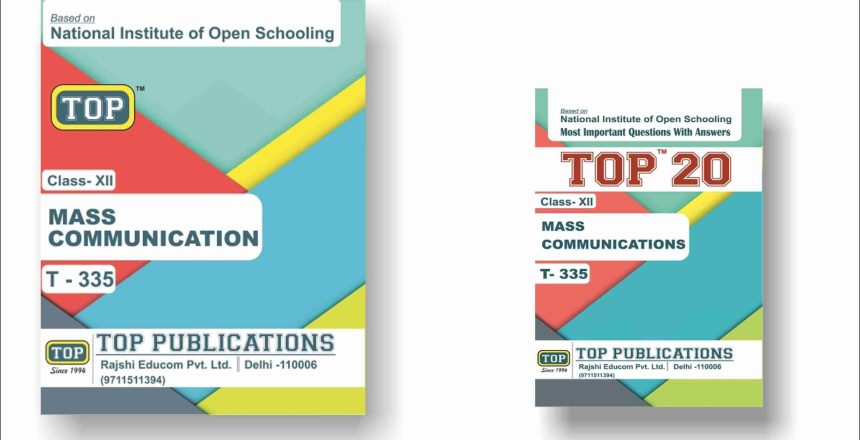Introduction:
The National Institute of Open Schooling (NIOS) stands at the forefront of educational innovation, offering flexible and inclusive learning opportunities. One of the notable initiatives by NIOS is the development of Class 10th books in vernacular languages, aiming to break down barriers to education and make learning more accessible to diverse linguistic communities. This blog post will also explore the significance of NIOS Class 10th books in vernacular languages, shedding light on how this initiative fosters inclusivity in education.
Understanding the Diversity of Languages in India:
India is a land of diverse cultures and languages, with each state boasting its own linguistic identity. This rich linguistic diversity, while a source of cultural strength, has presented educational challenges. In a traditional educational system, students from non-mainstream language backgrounds often need help understanding concepts presented in a language that may not be their mother tongue.
The Birth of NIOS Class 10th Books in Vernacular Languages:
Recognizing the need to address linguistic diversity and promote inclusive education, NIOS pioneered by introducing Class 10th books in vernacular languages. The objective was clear: to ensure that students across the country, regardless of their linguistic background, could access quality education in a language they are most comfortable with.
The Significance of Vernacular Language Education:
- Improved Comprehension:
- Education delivered in one’s mother tongue enhances comprehension and cognitive development. NIOS Class 10th books in vernacular languages aim to bridge the gap between the curriculum and students by presenting content in a language they are fluent in.
- Cultural Relevance:
- Learning in one’s vernacular language preserves cultural nuances and ensures educational content is relevant and relatable. It helps students connect with their roots, fostering a sense of cultural pride and identity.
- Increased Participation:
- Offering education in vernacular languages encourages more students to participate actively in the learning process. It reduces language-related barriers, making education more inclusive and accessible to a broader spectrum of the learners.
- Enhanced Retention:
- Studies indicate that students tend to retain information better when it is presented in their native language. NIOS Class 10th books in vernacular languages contribute to improved retention rates, ensuring a more effective learning experience.
Breaking Down Barriers to Education:
- Geographical Accessibility:
- The availability of NIOS Class 10th books in vernacular languages eliminates geographical barriers. Students in remote areas who may have limited exposure to Hindi or English, the predominant language of academic instruction, can now pursue education in their mother tongue.
- Inclusive Learning Environment:
- The move towards vernacular language education fosters an inclusive learning environment where students from diverse linguistic backgrounds feel valued and represented. This inclusivity is crucial for creating a supportive educational ecosystem.
- Empowering Local Communities:
- By providing education in vernacular languages, NIOS empowers local communities. It encourages the preservation and promotion of regional languages, contributing to the nation’s overall cultural and linguistic heritage.
Implementation Challenges and Solutions:
- Resource Development:
- Developing quality educational resources in multiple vernacular languages poses a significant challenge. However, collaborative efforts with linguists, educators, and local communities can help create linguistically accurate and culturally relevant content.
- Teacher Training:
- Ensuring that educators are equipped to teach in vernacular languages is crucial. Teacher training programs focusing on language-specific pedagogy and effective teaching methodologies can address this challenge.
- Infrastructure and Technology:
- Access to technology and digital infrastructure can be limited in certain regions. NIOS can work on providing offline resources, such as printed books and study materials, to ensure that students without consistent internet access can still benefit from vernacular language education.
Success Stories and Impact:
Highlighting success stories of students who have excelled academically with the support of NIOS Class 10th books in vernacular languages can provide tangible evidence of the positive impact of this initiative. These stories showcase how breaking linguistic barriers has opened doors to education for countless individuals.
Recommendations for Further Improvement:
- Expanding Language Options:
- Continuously expanding the range of vernacular languages in which NIOS Class 10th books are available can further enhance the inclusivity of the program.
- Community Engagement:
- Involving local communities in developing and reviewing vernacular language content ensures cultural accuracy and relevance. Community feedback can contribute to ongoing improvements.
- Awareness Campaigns:
- Conducting awareness campaigns about the availability of NIOS Class 10th books in vernacular languages can reach more students and encourage them to take advantage of this inclusive educational opportunity.
Conclusion:
In conclusion, NIOS Class 10th books in vernacular languages represent a significant stride towards inclusive education in India. By breaking down linguistic barriers, NIOS class has created a platform where students from diverse linguistic backgrounds can access quality education in a language that resonates with them. This initiative fosters inclusivity, empowers local communities, and preserves the cultural and linguistic fabric of the nation. As NIOS continues to evolve, the availability of educational resources in vernacular languages remains a crucial aspect of ensuring that every student has the opportunity to learn and the succeed, regardless of their linguistic background.
